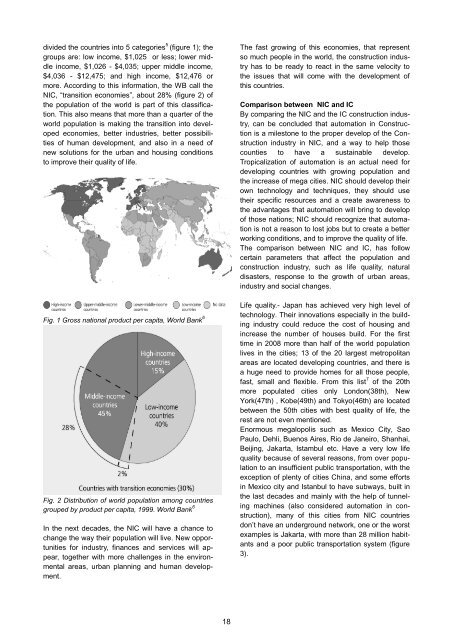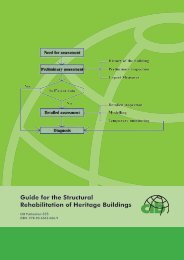Automated Construction - Test Input
Automated Construction - Test Input
Automated Construction - Test Input
Create successful ePaper yourself
Turn your PDF publications into a flip-book with our unique Google optimized e-Paper software.
divided the countries into 5 categories 5 (figure 1); the<br />
groups are: low income, $1,025 or less; lower middle<br />
income, $1,026 - $4,035; upper middle income,<br />
$4,036 - $12,475; and high income, $12,476 or<br />
more. According to this information, the WB call the<br />
NIC, “transition economies”, about 28% (figure 2) of<br />
the population of the world is part of this classification.<br />
This also means that more than a quarter of the<br />
world population is making the transition into developed<br />
economies, better industries, better possibilities<br />
of human development, and also in a need of<br />
new solutions for the urban and housing conditions<br />
to improve their quality of life.<br />
Fig. 1 Gross national product per capita, World Bank 6<br />
Fig. 2 Distribution of world population among countries<br />
grouped by product per capita, 1999. World Bank 6<br />
In the next decades, the NIC will have a chance to<br />
change the way their population will live. New opportunities<br />
for industry, finances and services will appear,<br />
together with more challenges in the environmental<br />
areas, urban planning and human development.<br />
18<br />
The fast growing of this economies, that represent<br />
so much people in the world, the construction industry<br />
has to be ready to react in the same velocity to<br />
the issues that will come with the development of<br />
this countries.<br />
Comparison between NIC and IC<br />
By comparing the NIC and the IC construction industry,<br />
can be concluded that automation in <strong>Construction</strong><br />
is a milestone to the proper develop of the <strong>Construction</strong><br />
industry in NIC, and a way to help those<br />
counties to have a sustainable develop.<br />
Tropicalization of automation is an actual need for<br />
developing countries with growing population and<br />
the increase of mega cities. NIC should develop their<br />
own technology and techniques, they should use<br />
their specific resources and a create awareness to<br />
the advantages that automation will bring to develop<br />
of those nations; NIC should recognize that automation<br />
is not a reason to lost jobs but to create a better<br />
working conditions, and to improve the quality of life.<br />
The comparison between NIC and IC, has follow<br />
certain parameters that affect the population and<br />
construction industry, such as life quality, natural<br />
disasters, response to the growth of urban areas,<br />
industry and social changes.<br />
Life quality.- Japan has achieved very high level of<br />
technology. Their innovations especially in the building<br />
industry could reduce the cost of housing and<br />
increase the number of houses build. For the first<br />
time in 2008 more than half of the world population<br />
lives in the cities; 13 of the 20 largest metropolitan<br />
areas are located developing countries, and there is<br />
a huge need to provide homes for all those people,<br />
fast, small and flexible. From this list 7 of the 20th<br />
more populated cities only London(38th), New<br />
York(47th) , Kobe(49th) and Tokyo(46th) are located<br />
between the 50th cities with best quality of life, the<br />
rest are not even mentioned.<br />
Enormous megalopolis such as Mexico City, Sao<br />
Paulo, Dehli, Buenos Aires, Rio de Janeiro, Shanhai,<br />
Beijing, Jakarta, Istambul etc. Have a very low life<br />
quality because of several reasons, from over population<br />
to an insufficient public transportation, with the<br />
exception of plenty of cities China, and some efforts<br />
in Mexico city and Istanbul to have subways, built in<br />
the last decades and mainly with the help of tunneling<br />
machines (also considered automation in construction),<br />
many of this cities from NIC countries<br />
don’t have an underground network, one or the worst<br />
examples is Jakarta, with more than 28 million habitants<br />
and a poor public transportation system (figure<br />
3).

















